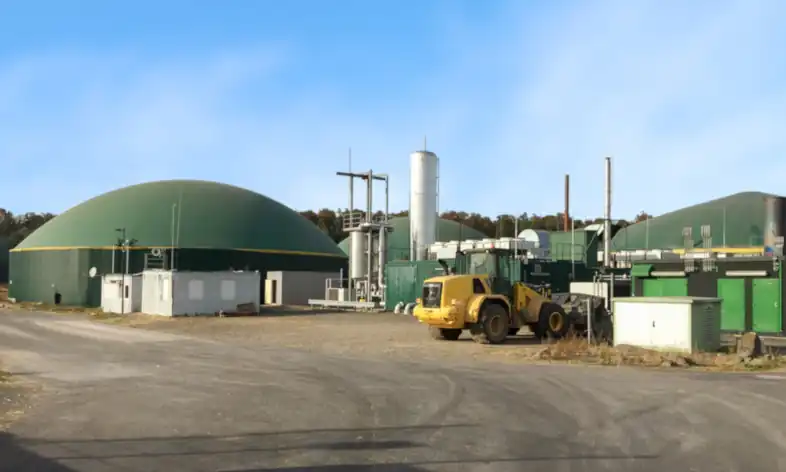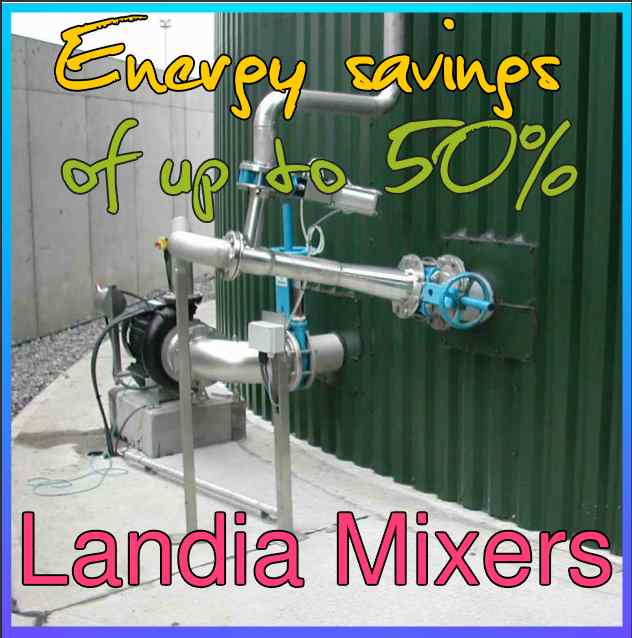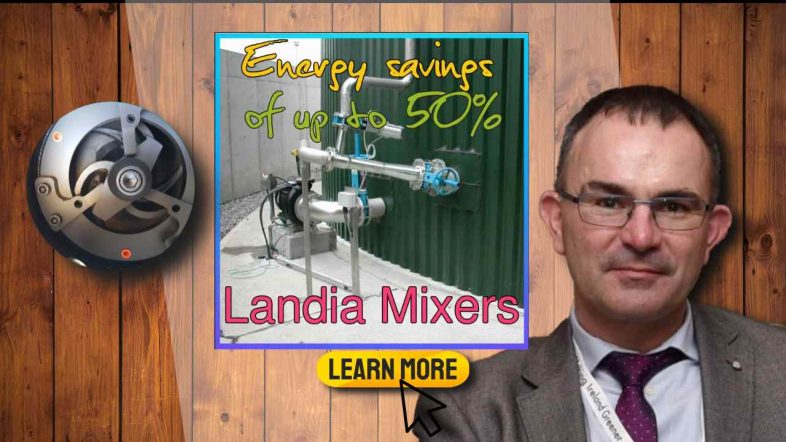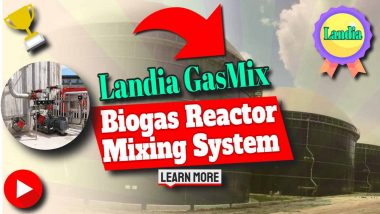Biogas plant mixing when “done right” will raise the gas yield per unit of biowaste feed and has been shown to halve digester mixing energy costs. That's a massive win-win and certainly raises biogas plant profitability. This has been demonstrated by Landia, when AD plant operators fit their proprietory GasMix equipment.
Read on to for the latest chapter of the Landia story:
The Landia GasMix system uses a Landia MPTK-GI chopper pump as a core component for mixing and processing anaerobic digester contents.
Press Release 1 April 2025:
Win-Win in the 75th year of the Landia Chopper Pump
Landia has won a rapid sequence of new orders from the Biogas and Waste Management industries for its renowned chopper pumps and mixers.
Invented by Landia back in 1950, the latest Chopper Pump sales have come from an expanding food waste AD plant in Northern Scotland, a textile processor, and a major landfill site.
For the AD/Biogas installation, the Landia Chopper Pumps will be supplied in stainless steel so that they can provide many years’ service in the high-acidity application.
The textile processor also requires pumps that provide the best possible total cost of ownership. In the push towards net zero, an increasing number of companies in this sector have been looking at utilising their waste streams as a feedstock for biogas.
Landia’s Technical Sales Engineer, Howard Burton, commented:
“We continue to see a strong demand for our innovative Landia Digester Mixing System (which features our proven Chopper Pumps and proprietary GasMix nozzle), and also for our stand-alone Chopper Pumps in a wide variety of biogas tank/digester/storage/blending applications.”
He added: “In the long-established sectors for leachate and waste liquid storage, where we have pumps and mixers installed all over the UK, the new orders include an 18.5kW POP-I Mixer and a DGER-I Chopper Pump.
“With our service team on hand, it is not uncommon at all to see Landia products go on to work for well over 20 years, even in very challenging environments.”

– Press Release Ends –
The original post from October 2021 follows:
Sponsored Post originally published on 28 Jan 2017:
Raising Biogas Plant Efficiency: 2016 was the Year of Massive Mixing Energy Reductions with Reactor Mixing Energy Savings of 50% Claimed for Retrofitted Landia GasMix Units

Landia is the company that quietly upped the game for the efficiency of biogas reactor mixing in 2016.
Landia has demonstrated how those fortunate plant operators that have adopted the Landia GasMix system are quietly pocketing the income for the AD plant operations and will continue to do so for the lives of their plants.
2016 was a year for many technological advances in anaerobic digestion, and in this blog, we have spoken of the awesome increases in biomethane production in the UK. However, of equal importance, but receiving far less publicity is the progress being made in the UK AD industry.
UK biogas plant operators are reducing sacrificial anaerobic digestion bioreactor mixing energy loads releasing energy that is sold. Every single kilowatt-hour (kW hr) expended on unnecessary energy loads expended on running any AD plant, becomes income toward the AD company's bottom line.
There are now (2016) about a hundred more AD plants operating in the UK than there were 1 year ago and many can benefit from improved mixing.
Back in 2014 we created the following video that provides a full explanation of how the GasMix system works. Watch it for the full 6 minutes to understand the many unique benefits of the system:

Landia Press Release Published in 2017:
AD/Biogas mixer manufacturer claims energy savings of up to 50%
AD Operators and water companies can reduce the energy usage of their digester pumps and mixers by up to 50%, according to the leading manufacturer, Landia.
“It is somewhat ironic that in an industry trying to create and save energy that there is so much energy being wasted”, said Landia’s Paul Davies.
“Poorly designed mixing systems located inside a digester, which are difficult to service, are typically using 7.5kW motors running flat out 24/7, using up 180 kW hours per day.
“Motors on externally-mounted systems that are also far easier to maintain may be bigger at 18.5 kW, but only have to run for 10-15 minutes per hour to achieve the same or often better results. Even at 15 minutes per hour, the energy usage is just 110 kW hours per day, compared to 180 kW. This is on just one mixer/pump, so the energy savings are substantial”.
It is not just Landia that are making claims for the high performance of their biogas plant mixing technology either, their clients are happy to confirm their gains, as the next section shows:
Ham Baker Director Provides Support for Landia Mixing Technology
During a key conference session at the 2016 UK AD and Bioresources conference, Ham Baker’s Business Development Director, Ian Goddard provided support for Landia's GasMix technology, as follows:
“It was a very timely and encouraging conference session put together by ADBA (Anaerobic Digestion & Bioresources Association),”
said Ian Goddard.
“Landia’s GasMix (Twice Highly Commended at UK AD & Biogas Industry Awards), which is easy to retrofit, is at the forefront of improving gas yields – a system we don’t make but have in our Renewables portfolio because we believe in it so much”.
He added:
“It is therefore heartening to think that the water companies can be less risk-averse – embracing such a low maintenance yet highly effective technology that allows them to greatly improve revenue”.
The fact that the Landia GasMix product is well respected within the UK Anaerobic Digestion Industry is also demonstrated by the highly commended rating their technology has been given by the top UK trade association for biogas plants in the UK, AD and Bioresources Association in their annual awards, as explained below:
Two ‘Highly Commended’ Placements for Landia GasMix at UK AD & Biogas Industry Awards
At its very first attempt, Landia gained two Highly Commended Honours at the much-coveted UK AD & Biogas Industry Awards.
In recognition of the success of its GasMix digester mixing equipment at the acclaimed Richgro AD plant near Perth, Landia was applauded by the independent panel of judges for the considerable part it has played in the first renewable energy site of its kind in the whole of Australia.
The externally-mounted GasMix system was chosen by Richgro for its enhanced gas yields, ease of service and reduction in volatile solids.
For pre-treatment, GasMix also reduces viscosity by 30% (as tested by the University of Aarhus in Denmark) and is energy-efficient, usually only needing to run for 7-10 minutes in the hour, so the consumed power is just one-sixth of the installed power.
Biogas Plant Mixing System
In addition, Landia's GasMix digester mixing system was also Highly Commended for its reliability and supreme performance at Eco Sustainable Solutions' food waste-to-energy AD plant in Dorset, where it has increased gas yields by a massive 12.5%.
A total of four Landia GasMix systems serve two 2500m3 digesters, utilising 18.5kW chopper pumps to generate a total of 700m3 gas per hour.
Total mixing is achieved via specially angled recirculation nozzles. Compared to many energy-burning systems that have to run flat-out, 24/7, Landia’s GasMix at Piddlehinton only needs to operate for approximately 10 minutes per hour. Despite using 18.5kW motors, compared to typical 7.5kW submersible units, GasMix has been shown to use fifty per cent less energy than the previous system.
The following video shows how this mixer works:
For more information about Landia GasMix™ biogas reactor mixers visit http://www.landia.co.uk/mixers/gasmix
[Previously updated 21 October 2021.]





Wow, your website is magnificent, let alone the content material!
For a well designed mixing system the distribution of power used in the mixing is very important. Excess power concentration in parts of the vessel can have a damaging effect, due to excess shear and elongation in high energy parts of the AD Plant system.
Mixing efficiency is hard to measure from power consumption. This is due to the three basic power loss centres being a) in the motor, b) the gearbox, c) the tank in which the mixing occurs. Each of these needs quantifying in order to get a reasonable prediction.
Unfortunately, most mixing system buyers fail to verify their energy usage, so there isn’t much information out there to compare efficiencies.